In July, pilgrims from across Canada visited battlefields, cemeteries and memorials in France,
Belgium and the Netherlands
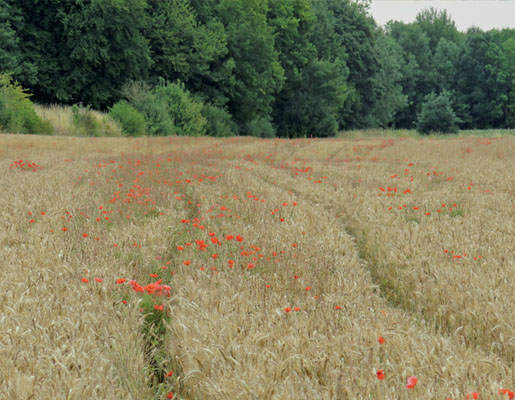
Poppies bloom in a wheat field where a costly attack by Britain’s 1st Lancashire Fusiliers against a German front-line fortification took place on the first day of the Battle of the Somme. [Eric Harris]
“If yesterday was the longest day,” says Ed Pigeau, “today was probably the hardest day.”
Pigeau is summarizing days 3 and 4 of The Royal Canadian Legion 2015 Pilgrimage of Remembrance during the daily after-dinner debrief. The longest day—Day 3—took the 27 pilgrims in detail through the first day of the Invasion of Normandy on June 6, 1944, when Allied forces crossed the English Channel to the north coast of France in the largest amphibious invasion ever. Coastal resort towns—Courseulles-sur-Mer, Bernières-sur-Mer, Saint-Aubin-sur-Mer—became battlegrounds, and Juno Beach became synonymous with Canadian valour.
Pigeau is a Dominion Vice-President of the Legion. He is also this tour’s head of mission. For two weeks in July, the group—nine RCL-sponsored pilgrims (one from each command across Canada, except Alberta) along with 17 companions and other paying guests—is travelling by coach from Paris to Caen, Dieppe, Ypres and Arras, stopping at farm fields, rural roadsides, beaches, battlefields, memorials, museums and cemeteries. Countless cemeteries.
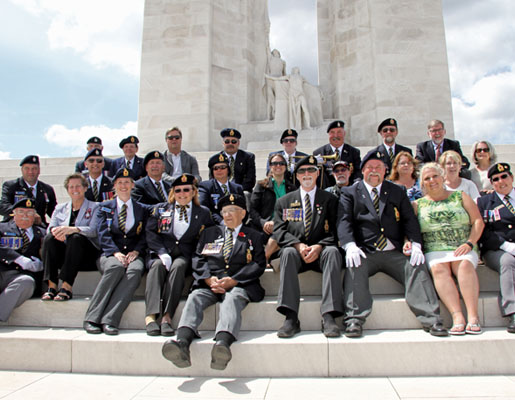
At the Canadian National Vimy Memorial in France where, following a commemoration ceremony, they gather for a group photo. Front row: Head of Mission Ed Pigeau, Donna Clark, British Columbia/Yukon Command pilgrim Amy Encina, Nancy McNight, William Harold Timms, Newfoundland and Labrador Command pilgrim Charles Piercey, Prince Edward Island Command pilgrim Brian Arsenault, Marsha Wedge, Nova Scotia/Nunavut Command pilgrim Daisy Marie Gavel. Second row: Pilgrimage Guide John Goheen, Pilgrimage Co-ordinator Steven Clark, Gary Springall, Saskatchewan Command pilgrim Shauna Grassing, Lucie Aubuchon, Serge Aubuchon, Kathleen Laskowski, Daphne Piercey. Back row: Ontario Command pilgrim Edmund “Manny” Raspberry, New Brunswick Command pilgrim Krista Blake, Richard Shields, Jack Grassing, Quebec Command pilgrim Marie-Anne Girard, Manitoba-Northwestern Ontario Command pilgrim Kenneth Milenko, Richard Krehbiel, David Eastaugh, Helen Eastaugh. [Eric Harris]
At every stop, guide John Goheen, an avid military historian and school principal from Port Coquitlam, B.C., tells it like it was.
“I warned you last night,” says Goheen at the end of Day 4. “I said today was going to be hard. I find several of the places we went today almost impossible, and I thought I held it together pretty well, because sometimes I don’t. It doesn’t matter how many times you go there, it’s just as hard.”
Those places—Abbaye d’Ardenne, Château d’Audrieu, The Orchard near Authie, and others—are scenes of extremely disturbing incidents.
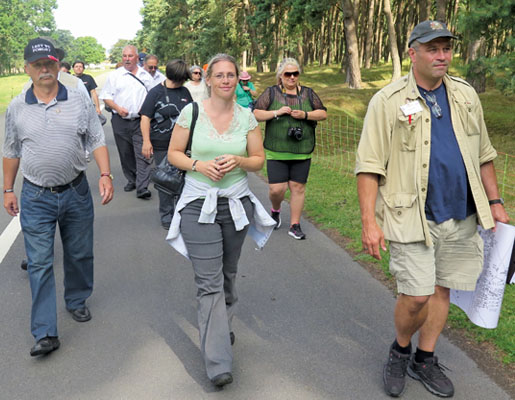
Led by guide John Goheen, pilgrims stride to the visitor centre at the Canadian National Vimy Memorial in France. [Eric Harris]
On June 7, 1944, at an abbey northwest of Caen, 11 Canadian prisoners of war, including one who was so badly wounded that he was a stretcher case, were separated from a group of 50 and moved through a courtyard doorway to the abbey’s side garden. These men “met a terrible fate,” says Goheen. “Those Canadians were led one at a time through a little blue door—the most haunting doorway I ever walked through—up to the garden where an SS trooper was waiting. From forensic evidence, we know that the men were shot or bludgeoned in the back of the head. Executed. This was not a reactionary battlefield murder. This was an order given, although with nothing on paper.”
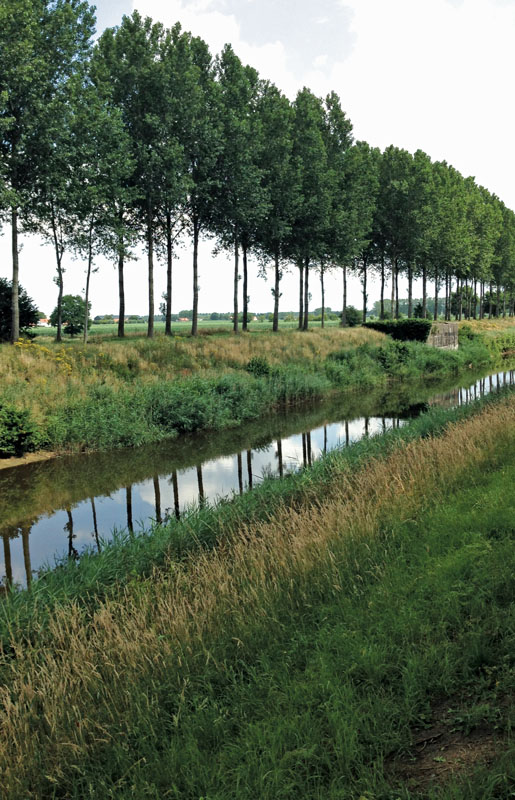
The Leopold Canal in northern Belgium was a line of German resistance during the Battle of the Scheldt. [Eric Harris]
Twenty prisoners were executed at Abbaye d’Ardenne in June 1944: James Elgin Bolt, Ivan Lee Crowe, Walter George Doherty, Charles Doucette, George Vincent Gill, Thomas Haliburton Henry, Reginald Keeping, Roger Lockhead, Hugh Allen MacDonald, Joseph Francis MacIntyre, Hollis Leslie McKeil, George Richard McNaughton, George Edward Millar, Raymond Moore, Thomas Edward Mort, James Alvin Moss, Harold George Philip, George Pollard, Freddie Williams and Thomas Alfred Lee Windsor.
Beside a road west of Caen is a wheat field. This is not unusual, considering that the Norman landscape resembles a hilly version of our prairies and that the French love their baguettes. What is unusual—and disturbing—is what transpired here 71 years ago, on June 8.
Some 150 members of the Royal Winnipeg Rifles were captured nearby in the battle for the town of Putot, and batches of prisoners were sent to different locations. Waffen-SS officer Lieutenant-Colonel Wilhelm Mohnke was livid that so many prisoners were coming in. He had no time for dealing with hundreds of Canadian PoWs, and he ordered his subordinates to take no more prisoners and to get rid of the ones they had. Forty PoWs were marched down this road, thinking they were being moved to a holding facility in a rear area, until a German staff car carrying Mohnke—according to an eyewitness—arrived. He started screaming at the German soldiers guarding the Canadian prisoners. The staff car left and the prisoners carried on until a German column came down the road. One of the last half-tracks in the column stopped, and a group of SS troops came out. They approached the prisoners and start yelling at the guards to go to the half-tracks and exchange their rifles for machine guns. The Canadians were told to sit in a semicircle in the tall wheat.
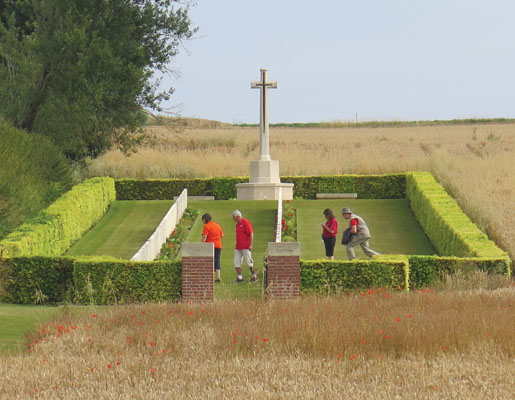
Beaumont-Hamel British Cemetery sits in what was no-man’s-land during the First World War. [Eric Harris]
One of the Canadians, an American by birth, was Lieutenant Reginald Barker of the 3rd Anti-Tank Regiment. Barker told the soldiers at the rear of the semi-circle: “The minute the firing starts, you start running.” The Germans approached the Canadians, and one of them said, “Now you die.” They opened up on the Canadians and all but five were killed, including Barker. The escapees were captured and survived as prisoners, and when the war ended, they told of what happened. There is no monument at this site, but in 2001, Barker’s alma mater, Queen’s University, established the Reginald Barker Memorial Award.
In the first week or so of the Allied invasion, more than 150 Canadian prisoners of war were executed by German soldiers.
Not every stop on the pilgrimage is so disturbing, but many are equally poignant.
The itinerary each day is packed: an abundant hotel buffet for breakfast, coach wheels rolling by 7:30 a.m., trivia questions and a morning march (The “Colonel Bogey March” gets everyone whistling), arrival at the first stop before 8 o’clock.
Goheen’s compellingly detailed orientations bring understanding and meaning to each site, large and small, from the overwhelming grandeur of the Canadian National Vimy Memorial to the minutiae of marks in a stone wall in Norrey-en-Bessin, made by Canadian tank commander Lieutenant George “Rip” Gordon, whose Sherman hit the building while squeezing through a narrow passage.
Standing beside the track-marked wall, pilgrim Kathleen Laskowski tells the group about her father Mike, who fought here on July 17, 1944, during the breakout from Caen, with the Royal Artillery’s 59th (Newfoundland) Heavy Regiment.
“He saw that some Germans were shooting at a nearby ammunition dump, which would have damaged his whole unit if it had blown up,” says Laskowski, “so Dad aimed his Long Tom gun at them and fired until they stopped.” He received a British Empire Medal for meritorious service, and she received a round of applause from the other pilgrims.
“Some Germans were shooting
at a nearby ammunition dump,”
says Laskowski, “so Dad aimed
his Long Tom gun at them and
fired until they stopped.”
On the outskirts of Authie, a kilometre northwest of the abbey, is a sandstone farmhouse owned by Denise and Daniel Collet. An elder couple, they exude warm Norman hospitality and affection for Canadians. Over snacks and copious apple cider made by Daniel’s cousin, they tell the pilgrims about life under German occupation. Daniel was 12 years old at the time of the war, and was living in a village near Authie. German soldiers were taking people out of their houses, giving them five minutes to pack up and leave, he says. His mother had a suitcase packed and they went to Caen just as the city was being levelled by Allied bombers. One relentless attack, he remembers, left fires burning throughout the city and many civilian casualties. After an hour of conversation and the presentation of gifts, we bid the Collets adieu, and they wave until the coach disappears from sight.
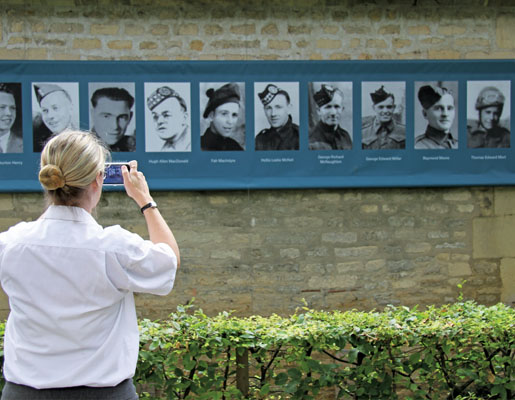
Pilgrim Encina photographs images of the 20 Canadian soldiers executed at Abbaye d’Ardenne.
Day 5 is all about the consolidation of northern Normandy and the closing the Falaise Pocket, all of which took much longer than the Allies anticipated. They had planned to take Caen, one of Normandy’s largest hubs, on D-Day, but had to fight a series of battles through June into July before the city, in ruins, fell.
While Germany was preoccupied with defending Caen, the First United States Army broke through their defences to the southwest in Operation Cobra, from July 25 to Aug. 8. This created the Falaise Pocket, where the Allies encircled the Germans on their retreat to the Seine River. The collapse of the German army in northwestern France ensued.
Canadians played no small role here, from their ill-fated attack on the Aéroport de Caen-Carpiquet on July 4-8 to the inspired leadership of Major David Currie, VC, who commanded a battle group of tanks, artillery and infantry at St. Lambert-sur-Dives, intent on denying the Germans an escape from the pocket. Under his command, 300 German soldiers were killed, 500 wounded and 2,100 captured. A well-known photograph shows Currie accepting the surrender of German troops here on Aug. 19, and several pilgrims are delighted to reenact that scene to a chorus of clicking cameras.
A two-hour drive takes the pilgrims back two years in time, to the disaster that was Dieppe. Day 6 begins on the West Headland, a cliff-top vantage overlooking this scenic resort with its chert beach, seawall and 15th-century Château de Dieppe.

Pilgrims explore the rocky beach at the village of Puys, east of Dieppe, where The Royal Regiment of Canada and The Black Watch (Royal Highland Regiment) of Canada, trapped between the beach and the sea wall, were decimated by German enfilade fire. [Eric Harris]
Having the closest beaches to Paris, Dieppe was the poor man’s Monte Carlo. It was also popular with artists and English tourists, which begs the question, didn’t the British military planners consider that the beach was not sand, and that their tanks would bog down in the chert?
Many more questions have been raised about the wisdom of the raid. The original plan, called Operation Rutter, was drawn up in the spring and planned for July. Dieppe was chosen because it was a port and close enough to England for air cover. Rutter was to be a two-tide, 15-hour operation with several key safeguards—hundreds of bombers to pound coastal defences, cruisers and battleships with 16-inch guns, tanks, paratroopers dropping to the east and west to take coastal gun emplacements by surprise—and the assumption that the German defences were relatively weak here.
The weather in July 1942 was terrible, and Rutter was called off. Renamed Operation Jubilee, the raid on Dieppe went ahead on Aug. 19, but most of those key factors had become compromised. The RAF thought heavy bombers would kill too many French civilians, so the bombers were removed. The Admirals didn’t like the idea of big battleships just off the coast, so they were replaced with destroyers with 4-inch guns. The geography gave the defenders a big advantage: from the clifftops, they could see from one end of the beach to the other, and every individual crossing it. And there were four times more German troops than originally thought.
The two flanking attacks landed first, before daylight, one to the west at Pourville (Green Beach), the other to the east at Puys (Blue Beach). The frontal assault, led by the Essex Scottish and the Royal Hamilton Light Infantry, started on Dieppe’s main beach (Red Beach) at 5:20 a.m. They were to be supported by the 14th Army Tank Regiment, but it arrived to the beach late. When it did
arrive, only 15 of 29 tanks made it across the seawall. Twelve got mired on the rocky beach and two sank.
Overall, some 5,000 Canadians, 1,000 British and 50 Americans landed in the raid. Almost 60 per cent of those who made it ashore were killed, wounded or captured. “It was a bad day all around,” says Goheen.

At Bretteville-sur-Laize Canadian War Cemetery, pilgrims Timms and Piercey place a wreath as Pigeau and Raspberry stand by. The cemetery contains 2,958 Second World War burials, the majority Canadian. [Eric Harris]
Day 8 detours northward into the Netherlands, where the First Canadian Army, an international force of Canadians, British, Polish, American, Belgian and Dutch soldiers fought the Battle of the Scheldt from Oct. 2 to Nov. 8, 1944.
The coach stops at the Leopold Canal, a major line of German resistance on what had been the Belgian-Dutch border. “This was one of the nastiest little battles the Canadians fought in Northwest Europe,” says Goheen. “A small-scale battle in a sticky little spot.”
The closing of the Falaise Pocket in late August defeated most of the German army in Normandy. The 50,000 who did get out were in a shambles and on the run for the Seine River with the British and Canadians in pursuit. The 11th British Division actually entered Antwerp, but capturing the biggest port in Europe wasn’t enough. Germany still controlled both sides of the Scheldt Estuary, the deep waters that link the port to the ocean 80 kilometres away.
Operation Market Garden—a huge airborne assault behind German lines—had failed in late September. The Allies faced a long, tough battle that wouldn’t end by Christmas, as hoped, and they needed a safe port here. Supplies were still being offloaded at beaches and ports in Normandy and trucked hundreds of kilometres north. Antwerp and the Schelt became top priority.
The Canadians, who dubbed themselves a “Cinderella Army” because they got all the dirty jobs and little glory, were tasked with clearing the estuary. The low-lying land interlaced with canals and drainage ditches, each a natural anti-tank obstacle, had been flooded by retreating Germans. Operation Switchback, planned by Lieutenant- General Guy Simonds, then acting commander of the First Canadian Army, called for two attacks on Oct. 6: one across the Leopold Canal, the other by amphibious assault craft across the Braakman, a large tidal inlet. The goal was to drive the Germans out from both sides.
As Oct. 6 approached, there weren’t enough amphibious assault craft for the attack across the inlet, but they decided to go ahead with the Leopold attack to draw the German forces out, and then cross the Braakman 36 hours later. Thirty-six hours became 60 hours, and the soldiers who crossed the canal were on their own for almost five days, clinging to the bank across from where the pilgrims stand.
Embedded in that bank, about 100 metres upstream, remains a pre-war bunker built by the Dutch before the Germans came through. The canal was part of the Dutch defensive line in 1940, but Germany took it over and used the bunkers after that. Cliff Chadderton, long-time executive secretary and CEO of the War Amputations of Canada, was hit by shrapnel from a grenade here and
lost his right leg below the knee.
The Braakman crossing succeeded. The Germans, with no avenue for retreat, surrendered en mass; more than 41,000 prisoners were taken. But the Allied casualties were staggering: 12,873 killed, wounded or missing, 6,367 of those Canadian.
On the morning of Nov. 3, a captain with 3rd Canadian Infantry Division wrote in the headquarters operations log: “Op SWITCHBACK now complete.” Another officer, looking over his shoulder, reached across the captain’s arm and, with his own pen, scrawled, “Thank God.”
Week 2 takes the pilgrims to 1914-18 and the First World War. It is a big shift of gears, back to a time more stark, more black-and-white, more formal, a time when artillery was horse-drawn and tanks were experimental.
The three-hour coach trip from Dieppe to Ypres pauses south of Calais at Wimereux Communal Cemetery, where 2,847 Commonwealth soldiers, including members of the Queen Alexandra’s Imperial Military Nursing Service, are buried.
Among the 219 Canadian burials here is Lieutenant- Colonel John McCrae of the Canadian Army Medical Corps. He is known universally, of course, as the poet who penned “In Flanders Fields.” The death of his friend Alexis Helmer in the Second Battle of Ypres on May 2, 1915, spurred him to draft the poem in an attempt to capture the strife of war.
The Canadians dubbed
themselves a “Cinderella Army”
because they got all the dirty jobs
and little glory.
“We had to learn this poem by heart at public school,” says Edmund “Manny” Raspberry, command pilgrim from Ontario.
The headstones here lie flat on the graves, too heavy to stay upright in the sandy soil. As we motor away from Wimereux, the coach’s loudspeakers fill with a children’s choir rendition of “In Flanders Fields,” bringing tears to pilgrims’ eyes.
On the shoulder of the expressway near Calais, a line of transport trucks, kilometres-long, idles. This is a major ferry port between France and England and the southern terminus of the Channel Tunnel rail link. Thousands of migrants fleeing violence in Syria, Somalia and Afghanistan have been camping in Calais and attempting to reach England by stowing away on trucks bound for cross-Channel ferries and tunnel trains. Security officials have slowed the transport traffic to a trickle. The strife of war is wide-ranging indeed.
Arriving in Ypres, pilgrims Laskowski, Daphne and Charles Piercey and Helen and David Eastaugh join up for a late lunch at Au Miroir, an outdoor cafe in Grote Market, the city’s large central square. The landmark Cloth Hall, a medieval building that was the hub in the city’s prosperous textile-driven economy—until First World War artillery destroyed it—dominates the architecture of this once-embattled city.
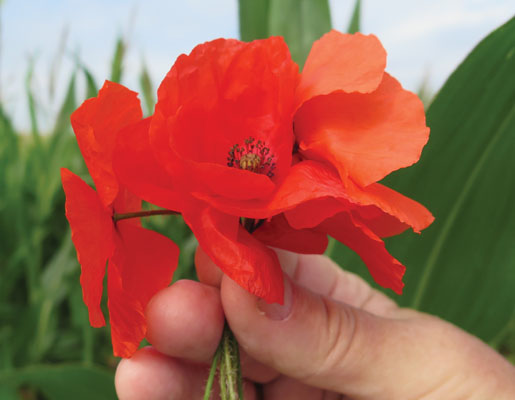
Poppies are omnipresent during the pilgrimage. [Eric Harris]
Pilgrims order croque-monsieurs, waffles and Passchendaele beer. “When opening a bottle of Passchendaele,” the label reads, “please hold a minute of silence to commemorate those who fell on the battlefield.”
For six packed days, the pilgrims retrace Canada’s baptism of fire. From Ypres to Arras and dozens of sites and cemeteries in between, Great War reference points—Passchendaele, Beaumont-Hamel, The Somme, The Hundred Days, Vimy Ridge—form chapter headings for sojourns across lands scarred by a mass slaughter. It was catastrophic, the worst of humanity, and it cost the lives of 7 million civilians and 9 million combatants, including 67,000 Canadians.
Each chapter has key places and words that emerge and merge: St. Julien, chlorine gas; Hawthorne Crater, ammonal exposives; Sunken Lane, machine guns; Christmas Truce, tactical stalemate; Menin Gate, graves unknown.
And each command pilgrim has an assignment. Months before the trip, the nine had been given the name of a soldier who died in the First World War and their task was to research that individual, then make a report to the group at that soldier’s gravesite. The result is nine eulogies in nine cemeteries.
For many, little information was available. For some, short but detailed life stories could be cobbled together. Kenneth Milenko, command pilgrim from Manitoba-Northwestern Ontario, located and photographed the house in Winnipeg where Frederick Driver lived before enlisting and serving with the 78th Battalion (Winnipeg Grenadiers). Sergeant Driver was killed in action on Vimy Ridge on April 9, 1917, at the age of 22.
“I don’t know if any of Sergeant Driver’s family have ever visited and paid their respects or offered their thanks,” says Milenko. “But what I do know is that we’re here today doing just that, and saying a few words on all of Canada’s behalf.” Milenko ends his report by placing the photo, a poppy and a Canadian flag at Driver’s headstone.
Eight other pilgrim reports, nine formal commemoration ceremonies and several informal wreath-placings take place through the two-week tour, each one a moving gesture of remembrance.

Denise (in pink) Collet of Authie, France, offers cider and sweets to visiting pilgrims. [Eric Harris]
Another wheat field, another battlefield. On the final day en route back to Paris, the coach pulls over on the outskirts of Beaumont-Hamel and rolls slowly backward up a narrow cul-de-sac lane. Alongside the lane are high banks with dense undergrowth that makes it feel almost like a tunnel.
This is the Sunken Lane, a starting point of the Battle of the Somme. Some 500 members of the British 1st Battalion Lancashire Fusiliers had been waiting in this hiding place near the village of Beaumont-Hamel since long before dawn on July 1, 1916. Official British military cinematographer Lieutenant Geoffrey H. Malins was here too, and he trained his camera on them for less than a minute before they went over the top at 7:30 a.m., zero hour. Their attack was fully exposed to direct German machine-gun fire. Within 20 minutes, most were dead or wounded. By noon, only one officer and 25 soldiers remained alive.
The pilgrims form up for a re-enactment, and with two toots of Goheen’s military whistle, charge over the top, following in century-old ill-fated footsteps.
Before the final post-dinner debrief, the pilgrims are asked to try, one by one, to sum up their experience in two minutes or so. Some speak shorter, some longer, but all talk eloquently of their impressions and the impacts of the tour.
“What we saw, the things we did, going over the hill today at the Sunken Lane, looking at the graves, the marks in the land, Normandy, Dieppe, Vimy, these are all sacred places of incredible bravery,” says Pigeau. “Knowing that their Armageddon is on the other side of the hill, I can’t imagine the guts of a person who steps over that steps over that hill.”
“I don’t know if any of Sergeant Driver’s
family have ever visited,” says Milenko.
“But what I do know is that we’re here
today doing just that.”
“I came on this tour with no expectations. I just knew we were going to see some battle sites and learn some history,” says Krista Blake, command pilgrim from New Brunswick. “What hit me the most was walking in the cemeteries with all these headstones. All the names and the ages, 19 and 20 years old. My daughter is 21, and I cannot imagine having her friends go and never come back. I took Canadian history in school, but that was nothing like what we learned here.”
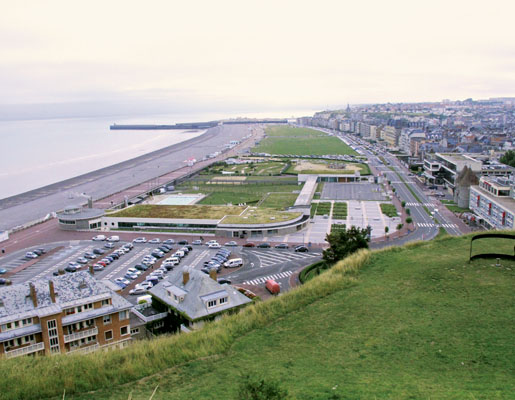
From the West Headland overlooking the Dieppe beach, German defenders had a clear view of every soldier landing on it. [Eric Harris]
“There were a couple of kids at the Vimy Memorial and I gave them Canadian flag pins,” says pilgrim Gary Springall of Nova Scotia. “And I gave their parents a Canadian flag. I told them where I was from and about the pilgrimage and I asked where they were from. Dusseldorf, Germany, they said.
“In the 1940s, we were fighting against them. They were the enemy. In the 1970s, I was in Hamburg, Germany, in the Canadian military with NATO. For me, that moment at Vimy was a reminder that we are all one human family, and my hope is that someday we will just have peace, not war.”
Advertisement


















